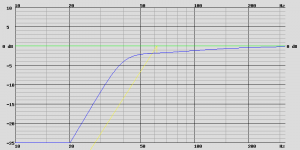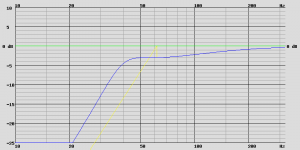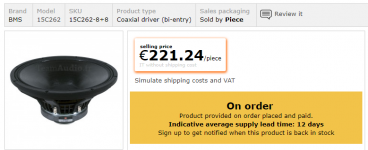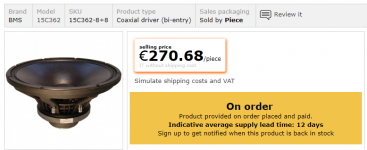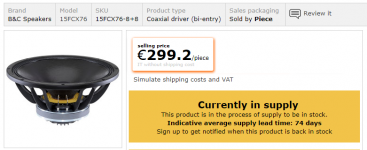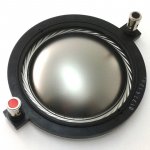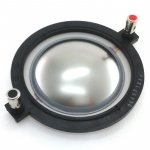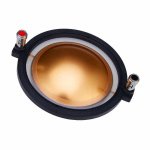I was mistaken. According to gearslutz, by 1967 Abbey Road was mastering with an Altec 605A in a 612 cabinet. So your recollection is much closer.
Hmm, now I got to go dig through my old stuff, the 612 is right, but don't recall any 'foreign' studios using the 605.
Regardless, the point is that for decades, pretty much anybody famous did it through coax speakers, so why fix what ain't broke?
GM
When I first started this thread my thought train was a top coaxial crossed to a bass woofer...We discussed that there where no studio quality coaxials on the market for anything less than just short of a fortune........as I look on ebay at used 604 drivers....yeah they aren't cheap by any means. Somehow we got on the topic of horns, and I searched out and was able to audition a pair of Altec clones with 511 horn an some altec woofer....and fell in love...was taken back even...then I played some electronic music and became discouraged, but then I searched out some more current horn driven pa (QSC/jbl/etc) speakers and regain my faith in compression drivers.
The main stay that kept me so fueled about Horns were the comments that went "bad recordings sound really bad" "high dynamic contrast" "high directivity, less room energy".... All that sounds like the studio engineers dream loudspeaker. I want a bad recording to sound bad....is it the low IMD that causes a Horn to do this? High dynamic contrast means that lows are lower and highs are higher in comparison to say a dynamic driver...which should equate to a magnified view of the spectrum and result in precise eq decisions. Geddes says that the dynamic contrast is a result of audible diffraction, that increases with spl....not sure if it is sensitive enough to help me eq, but there's a crap ton of opinions who find this "audible diffraction" desirable. PhaseAccurate says that the lack of non linear distortion results in the less subjectivity in the assumption of loudness, which once again sounds great for eqing.....horns have low IMD....when used correctly....multiways have less IMD....Transmission lines have less imd, though the box is big....IMD is non linear distortion right? What else falls into this camp.....Less room and more direct signal, thats a no brainer.
So you may see why I wanted to cover as much spectrum with horn as I can... plus getting the 15" down into a lower Ka helps lower listening distance. So now I'm looking at purchasing a axi2050 to reach the lowest xover possible....what if we discuss tweeters? Are there other midrange horns that fit into my project? I've heard that tweeters are hard to incorporate...what about the JBL 075. I've seen only bullet tweeters with horn systems....why? Whats the dispersion like?
The main stay that kept me so fueled about Horns were the comments that went "bad recordings sound really bad" "high dynamic contrast" "high directivity, less room energy".... All that sounds like the studio engineers dream loudspeaker. I want a bad recording to sound bad....is it the low IMD that causes a Horn to do this? High dynamic contrast means that lows are lower and highs are higher in comparison to say a dynamic driver...which should equate to a magnified view of the spectrum and result in precise eq decisions. Geddes says that the dynamic contrast is a result of audible diffraction, that increases with spl....not sure if it is sensitive enough to help me eq, but there's a crap ton of opinions who find this "audible diffraction" desirable. PhaseAccurate says that the lack of non linear distortion results in the less subjectivity in the assumption of loudness, which once again sounds great for eqing.....horns have low IMD....when used correctly....multiways have less IMD....Transmission lines have less imd, though the box is big....IMD is non linear distortion right? What else falls into this camp.....Less room and more direct signal, thats a no brainer.
So you may see why I wanted to cover as much spectrum with horn as I can... plus getting the 15" down into a lower Ka helps lower listening distance. So now I'm looking at purchasing a axi2050 to reach the lowest xover possible....what if we discuss tweeters? Are there other midrange horns that fit into my project? I've heard that tweeters are hard to incorporate...what about the JBL 075. I've seen only bullet tweeters with horn systems....why? Whats the dispersion like?
It's funny camplo, I'm up to my neck in coaxials at the moment and wonder why one would go through all the hassle of individual horns and woofers if you could have this, with a coax driver that costs less than most 15-inch woofers and has all the features that are considered important:
An externally hosted image should be here but it was not working when we last tested it.
Last edited:
Contrary to my expectations, this driver (BMS 15C262), as well as its bigger brother (15C362) would drop right into my cabs and cover 35-20k (in-room) with an extended bass shelf, padded down to compensate for baffle step. Total cost: less than €600.
It seems the 15C363 could be crossed even slighty lower.
It seems the 15C363 could be crossed even slighty lower.
Attachments
Last edited:
So what did you do to deserve such 'abuse'?
GM
Revealing this would be too much "Rock 'n Roll" for this forum I think
Something with ... abandon ones beliefs as a result of ...
But never mind
I've checked the Eminence KL3015CX-8 and the modified versions of Erich for DIYSG.
Although these look good on paper, I doubt that they would beat the BMS coaxials.
BMS woofers are among the best available, which also applies to their compression drivers.
In addition, on this side of the pond, the KL3015CX-8 alone is more expensive than the 15C262.
So you still have to buy the Celestion comp. driver and probably end up with a crossover at 1400Hz, which is slightly higher than I would like.
But never mind
I've checked the Eminence KL3015CX-8 and the modified versions of Erich for DIYSG.
Although these look good on paper, I doubt that they would beat the BMS coaxials.
BMS woofers are among the best available, which also applies to their compression drivers.
In addition, on this side of the pond, the KL3015CX-8 alone is more expensive than the 15C262.
So you still have to buy the Celestion comp. driver and probably end up with a crossover at 1400Hz, which is slightly higher than I would like.
Last edited:
Beatles Mixing Desk @ Abbey Road, Studio 2:
And a doc. on the gear:
An externally hosted image should be here but it was not working when we last tested it.
And a doc. on the gear:
Attachments
Way higher than I would like! 1000 Hz for a 15" same as the 604B duplex.
The problem with youth is that we are too impressionable/aware of our surroundings and [un]fortunately for me the first Altec I was exposed to [other than in a large movie palace] was the 604B in this H110 cab.
With basically no Xmax combined with an A-323 amp, it had 'tone' to die for and spent the better part of 15 yrs trying to capture it in a then 'modern', high power multi-way horn system. Got real close, but 'no cigar'.
Fast forward to Danley's SH96 and after experiencing it, firmly believe that the basic design except with a ~5/8th throat/1" exit driver coupled to a suitable variable DF tone controls tube amp will get most of it.
The part of the tone due to lack of Xmax I can do without, the big system's 'heart attack' fast transients all the way up spoiled me. .
.
GM
The problem with youth is that we are too impressionable/aware of our surroundings and [un]fortunately for me the first Altec I was exposed to [other than in a large movie palace] was the 604B in this H110 cab.
With basically no Xmax combined with an A-323 amp, it had 'tone' to die for and spent the better part of 15 yrs trying to capture it in a then 'modern', high power multi-way horn system. Got real close, but 'no cigar'.
Fast forward to Danley's SH96 and after experiencing it, firmly believe that the basic design except with a ~5/8th throat/1" exit driver coupled to a suitable variable DF tone controls tube amp will get most of it.
The part of the tone due to lack of Xmax I can do without, the big system's 'heart attack' fast transients all the way up spoiled me.
GM
Your experience with the 604B sounds familiar to mine, albeit with CODA and D&B Audiotechnik monitors (featuring the 12 and 15" BMS coaxials).
Did you listen to the SH96 non-HO version? I've only heard the HO (with the woofers high passed) and noticed a distinct horn signature, "the cuppy sound".
Perhaps, this was due to the woofers MIA, but it made me wonder if I could live with such a sound at home.
Did you listen to the SH96 non-HO version? I've only heard the HO (with the woofers high passed) and noticed a distinct horn signature, "the cuppy sound".
Perhaps, this was due to the woofers MIA, but it made me wonder if I could live with such a sound at home.
GM, this one: Eminence Beta 12 CX + Selenium D210Ti MLTL (huge)
Ro808 - yes, but the BMS is considerably cheaper.
Ro808 - yes, but the BMS is considerably cheaper.
Krivium, You seem to have quite a lot of experience in studio work or at least with studio monitors.
Well let's say it used to be my day job (at the desk or fixing different technical things) in a former/previous life.
I would extrapolate that to steep phase changes vs linear phase. Not a big difference in the short term but better in the long run. Still controversial of course.
I'm with you about this ErnieM.
Like light, with sound our ears always seek to equalize, some aspect that has been accepted as passable, allowing other aspects of grandeur to not lose face, may stand out as obvious once the passable aspect is directly contrasted by the audition of another loudspeaker that succeeds greatly at the aspect the other loudspeaker only passes as good enough.
I agree with that. One of the reason you have different tools ( loudspeakers) in a control room. Switching from one to another help to have objectivity about the work to be done. I can testify too that switching in different order ( from Mains to nearfield and vice versa) put different things in light which may not be obvious.
We have poor sound memory long term (short time depend from individual to another).
I personally think IMD is really important when judging eq is the task, IMD and power compression augment the level of frequencies produced. As well, having the source become singular helps in the perception of balance or unbalance of the spectrum. I couldn’t tell you which plays a bigger role but I feel IMD is a larger factor and that it can even increase power compression.
Well i understand your concerns and overall i tend to agree but ime this is not true or at the very least this is not universal.
There is a lot of variation between us in what we listen to and how we react about that ( in professional context). I tell that from my experience in studio, some engineers blew my mind using tools i would have put in the junk... or doing things not in the manuals, and results were good still...
One thing i am sure is that for eq (and more generally speaking about quality assessment) there is more about skills of operator and them being used to the tools used than the tools themself.
Ever thougt about the fact that from early 80's up to 2000's 95% of music ever produced was mixed on NS10? Those are plagued with imd and thd, poor spl capability, flaws in the xover, maybe one of the worst loudspeaker you can think of. However this was ( are) used.
If you could not make correct assesment of tonal balance (thus eq) on this overall sound quality from this past age would have been unlistenable.
In practice this is not the case ( you could argue that the 'sound' is made at tracking where you use Mains more often or that overall sound quality degrading is result of loudness war and you would be right but still mixing is important).
One of the mastering engineer i worked with used some Dynaudio BM15a ( or Quested V2108a) located in a 'post production isolating booth' 3m2 surface with incredible results. Even played on big soundsystems the tracks just sounded right.
You can't compete with 30 years experience and knowing your tools praticing 12hours a day.
That said i'm with you about your quest of good quality reproduction sound system.
Horns/waveguides are goods, mid domes are goods, coax can be good... who cares the bottle as long you like what you drink and end up... being drunk?
Last edited:
Dynaudios are still popular for production work. I know several professionals that have been using BM series for years.
For listening, Dynaudios can sound quite dull/lifeless, especially their passive consumer speakers.
Their drivers are top notch, but the crossovers are far from ideal. At least this was true for the smaller Contour and Crafft 2-ways I owned.
For listening, Dynaudios can sound quite dull/lifeless, especially their passive consumer speakers.
Their drivers are top notch, but the crossovers are far from ideal. At least this was true for the smaller Contour and Crafft 2-ways I owned.
Last edited:
I had a feeling they mixed with a speaker around that size.Beatles Mixing Desk @ Abbey Road, Studio 2:
The journey of Adolf Corkscrew with the B&C 15FCX76 is quite interesting.
He starts with a number of clearly defined objectives and finally manages to 'tame' the B&C coaxials by using strictly passive crossover components.
He was probably unaware of the somewhat harsh sound of the all-Titanium MMD3BTN8M diaphragms in the compression driver (first image attached).
As with the older B&C MMD3A8 3" diaphragms, Mylar (soft) suspended versions of the same diaphragms are available. These usually exhibit a less severe breakup peak and better damping of resonances in the top octave.
B&C usually mounts the hard suspended variants because of their durability / heat resistance.
There is a reason why 18Sound has switched from hard to Mylar suspended membranes for the 1" ND drivers (ND1070-ND1095).
I would immediately exchange the MMD3BTN8M for the MMD3B8M (2nd image), or try a pair of coated aftermarket diaphragms (3rd image) for 1/5 of the price.
He starts with a number of clearly defined objectives and finally manages to 'tame' the B&C coaxials by using strictly passive crossover components.
He was probably unaware of the somewhat harsh sound of the all-Titanium MMD3BTN8M diaphragms in the compression driver (first image attached).
As with the older B&C MMD3A8 3" diaphragms, Mylar (soft) suspended versions of the same diaphragms are available. These usually exhibit a less severe breakup peak and better damping of resonances in the top octave.
B&C usually mounts the hard suspended variants because of their durability / heat resistance.
There is a reason why 18Sound has switched from hard to Mylar suspended membranes for the 1" ND drivers (ND1070-ND1095).
I would immediately exchange the MMD3BTN8M for the MMD3B8M (2nd image), or try a pair of coated aftermarket diaphragms (3rd image) for 1/5 of the price.
Attachments
Last edited:
- Home
- Loudspeakers
- Multi-Way
- Is it possible to cover the whole spectrum, high SPL, low distortion with a 2-way?
